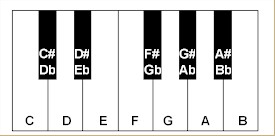
Fretboard
Theory
Lesson 1 - Intervals
Lyle: Let's see how well you know your
intervals. Try this quiz: Starting on low F, 6th
string 1st fret, go up a Minor 3rd (Ab), up a Flat 5th (D), down a Minor 6th, up
a Major 3rd, up a Perfect 5th, down a Perfect 4th, down a Major 3rd, up an
Octave, down a Flat 5th, up a Major 2nd. What note are you on
now?
interval quiz
answer 1
Lyle: How did you
do? First you have to get to know your fretboard and the name of the notes. Then
you need to be aware what intervals are. First….Let's assume you have a standard
22 fret electric guitar.
Lyle: How many A notes do you have on your
fretboard?
Lyle: Here's the answer for those of you with 22
frets:
all the A
notes
Lyle: Find and play all the A notes a quick as
you can. Be accurate. Notice the pattern that lays out on the fretboard. Note: If you're using an acoustic guitar you may not be
able to find and play all the notes shown here.
Lyle: Here's all the B
notes:
all the B
notes
pyite20v: Why
did you pick that pattern of skipping the strings?
Lyle: Best pattern I could come up with. I can
play all 12 - A notes real fast using this pattern.
Lyle: There are only 12 different tones in music.
7 are natural notes, 5 are accidentals also know as sharps and flats. On a
piano, all the white keys are the natural notes, the black keys are the
accidentals.
notes
on the keyboard

Lyle: Notice there is no black key between the B
& C, and the E & F notes.
Lyle: On the fretboard, all the natural notes are
2 frets apart except for the B & C, and E & F notes, which are 1 fret
apart.
Lyle: View this TAB on the virtual neck to see
all the natural notes on the fretboard:
All the Natural Notes
Lyle:
Notice that the natural notes are all 2 frets apart except for B & C, and E
& F.
Lyle: The term “Whole Step” means 2
frets.
Lyle: The term “Half Step” means 1 fret. The
interval between E & F is a half step. The interval between A & B is a
whole step.
Lyle: Now you should learn what intervals are
because they are used when learning scales, chords, and arpeggios. You need to
understand and memorize these intervals names and fretboard
locations.
Lyle: An interval is the distance between
any two notes.
Lyle: Minor 2nd = 1 half step / 1
fret
Minor
2nd
Joel: I
studied this in piano... this almost makes sense. :) lol
Lyle:
Good!
g: So B to
C is a minor 2nd?
Lyle:
Yes!

Lyle: Major 2nd =1 whole step / 2
frets
Major 2nd

Lyle: Minor 3rd =1 ½ steps / 3
frets
g: Whether
the note you end up on is natural or not makes no difference when you refer to
intervals?
Lyle:
Correct!
Minor
3rd
Lyle: A to C is a Minor 3rd
interval.
Lyle: F to G# is a Minor 3rd
interval.
Lyle: G to Bb (flat) is a Minor
3rd.
Lyle: D to F is a Minor
3rd.

Lyle: Major 3rd = 2 whole steps / 4
frets
Major
3rd
pyite20v: Does the "sound" of say going up a major 3rd,
feel the same going from any note to any note?
Lyle: Yes, it will.

Lyle: Perfect 4th = 2 ½ steps / 5
frets
Perfect
4th

Lyle: Flat 5th = 3 whole steps / 6
frets
Flat
5th

Lyle: Perfect 5th = 3 ½ steps / 7
frets
Perfect
5th

Lyle: Minor 6th = 4 whole steps / 8
frets
Minor
6th

Lyle: Major 6th = 4 ½ steps / 9
frets
Major
6th

Lyle: Minor 7th = 5 whole steps / 10
frets
Minor
7th

Lyle: Major 7th = 5 ½ steps / 11
frets
Major
7th

Lyle: Octave = 6 whole steps / 12
frets
Octaves

Minor 2nd = 1 half step / 1 fret
Major 2nd =1 whole step / 2 frets
Minor 3rd =1 ½ steps / 3 frets
Major 3rd = 2 whole steps / 4
frets
Perfect 4th = 2 ½ steps / 5 frets
Flat 5th = 3 whole steps / 6 frets
Perfect 5th = 3 ½ steps / 7 frets
Minor 6th = 4 whole steps / 8
frets
Major 6th = 4 ½ steps / 9 frets
Minor 7th = 5 whole steps / 10
frets
Major 7th = 5 ½ steps / 11
frets
Octave = 6 whole steps / 12
frets
Lyle: Playback this TAB notation of the
G major scale:
G
major scale
tiff: Why is
there an exception on the B and E
strings?
Lyle: Because of the way the guitar is tuned in
4ths, but the B string is a Major 3rd above the G string.
Lyle: Playback this tab notation. It's in the key
of C major. You'll see the intervals laid out for the key of
C:
Key of C
Lyle:
If you go from 6th string 5th fret (A), go up a Major 7th (11 frets), you'll be
on G#.
Lyle: If you start on 6th string 5th fret (A) and
go over two string to the D string 6th fret, you'll be on G#, a Major 7th above
where you started, 11 frets worth.
Lyle: Down the neck is by the tuners, the sound
is lower and the fret number is lower, up the neck is towards the body, the
higher fret numbers and the higher
sound.
Joel: Do
you have go down to go up an interval?
Lyle: Joel, you don't have to go UP the string to
go up an interval. Example: a major 3rd:
G Major 3rd
Lyle:
Here's another interval quiz. Starting on low G, 6th string 3rd fret, go up a
Minor 6th, go down a Major 2nd, go up a Perfect 5th, go up an Octave, go up a
Minor 3rd, go down a Perfect 4th, go up Minor 2nd, go down a Major 6th, go up a
Minor 7th. What note are you on now?
interval quiz answer 2

Lyle: Starting on F#, 6th string 2nd fret, go up
a Major 7th, go down a minor 3rd, go down a perfect 4th, go up a Flat 5th, go
down a Minor 2nd, go up a Major 6th, go down a Major 3rd, go up a Major 2nd, go
down an octave. What note are you on
now?
interval quiz
answer 3

Lyle: Starting on E, 9th fret 3rd string, go up a
Major 3rd, go down an Octave, go up a Minor 7th, go down a Major 3rd, go up a
Perfect 4th, go down a Major 7th, go up a Perfect 5th, go up a Minor 2nd, go
down an octave, go up a Major 6th, go up a Minor 3rd. What note are you on
now?
interval quiz
answer 4
Lyle:
Remember this chart:
Minor
2nd = 1 half step / 1 fret
Major
2nd =1 whole step / 2 frets
Minor
3rd =1 ½ steps / 3 frets
Major
3rd = 2 whole steps / 4 frets
Perfect
4th = 2 ½ steps / 5 frets
Flat
5th = 3 whole steps / 6 frets
Perfect
5th = 3 ½ steps / 7 frets
Minor
6th = 4 whole steps / 8 frets
Major
6th = 4 ½ steps / 9 frets
Minor
7th = 5 whole steps / 10 frets
Major
7th = 5 ½ steps / 11 frets
Octave = 6 whole steps / 12
frets
Lyle: So if I asked you to go down a Perfect 5th,
how many frets would that be?
tiff: 7?
Lyle: Yes, good.
Lyle: Music theory can come quick and some of it
takes longer to sink in. I plan on teaching you what I feel you should know,
starting with these intervals.
Lyle: Let's take a break. Next lesson is on
scales.